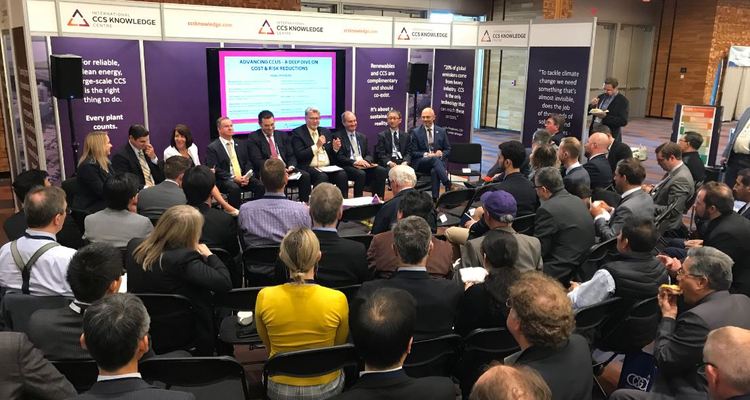Touted by United Nations as a necessary and ready-to-go technology in the urgency to mitigate climate change, carbon capture and storage (CCS or CCUS) was on the agenda at the Clean Energy Ministerial (CEM). Held in Vancouver, in the spring, CEM is a global gathering of international energy ministers with the common goal to advance clean energy technology, to share lessons learned and best practices, and to encourage the transition to a global clean-energy economy.
The International CCS Knowledge Centre along with CEM’s CCUS Initiative provided platforms at CEM for the exploration of the hurdles and possibilities in advancing CCUS as a key technology to significantly reduce greenhouse gas emissions (GHGs). CEOs, senior executives in the financial sector and ministers discussed how to move forward with CCS in the short term to achieve tangible progress.
CCUS was championed at the event by Fatih Birol the head of the International Energy Agency; Michal Krutyka the Minister of Energy for Poland and President of COP24; and Steve Winberg, the Assistant Secretary for Fossil Energy for the USA; among many others.
Internationally there is recognition that definitive action is needed to support the world’s ability to tackle the climate crisis. Mr. Birol reminded the attendees at the gathering focused on accelerating CCUS that 30 years ago, global energy supply was 81% sourced from fossil fuels – today energy source remains the same, despite strong growth in renewable energy.
With the slow pace to transition away from fossil fuels and the increased urgency for action on decarbonization, CCUS needs to be an active part of the toolkit now and into the future. At large-scale, it facilitates deep cuts in GHGs. As Niall MacDowell of the Imperial College of London pointed out, the 2-degree target is a sizable challenge, “As we move beyond that, to the Paris Agreement, part of aspiration towards 1.5-degrees, the value of CCS goes up, not down.”
CCUS Detours
Despite its proven success and accessibility, CCS has suffered a perception of high cost and thus lack of investment. With the advent of innovation toward second-generation in the technology, costs are shown to plummet by 67%, per tonne of carbon dioxide (CO2) captured, opening opportunities for investment.
Expert panelists at various sessions stressed that carbon capture is nothing new – the technologies exist and are deployed around the world. Tim Thomas, Vice President at Mitsubishi Heavy Industries says that it is through replication that sees the greatest benefits in cost and efficiencies. “We’ve done the R&D. We need to implement CCS projects – the largest gains in knowledge come from operating large-scale facilities.”
It was widely agreed that it is the lack of policy or policy uncertainty that impedes deployment. During the session on financing CCUS, panelist reiterated that markets alone cannot drive most CCUS projects – that clear and stable policy drivers are required. In most countries, these are still missing. Representatives from the financial sector said that they would be ready in invest in CCUS when it is included in a broad definition of clean energy – and when there are consistent regulations and incentives by governments as well as clear commitments from industry.
Optimism for CCUS
A convergence of industries and government along with policy mechanisms could drive the tipping point that is needed for on mass deployment of CCUS. Mr. Kurtyka remarked on the need for international cooperation. “We have the frameworks (Paris Agreement, Katowice Rulebook from COP 24), we have the innovation of technologies, we need people.” Rich Powell, CEO of ClearPath out of Washington DC, spoke of two keys to allow for rapid scale-up of CCUS, specifically significant regulatory relief and an enabling environment in civil society. “With societal acceptance, CCS can be seen as part of a low-carbon toolkit right alongside wind, solar, efficiency and other great innovations coming out of this space.”
The discussions at CEM underscored the point that if the world is serious about emission reduction, then it better be serious about large-scale CCUS. “However CCUS is not an exclusive club. We need everything to meet goals to reduce GHG emissions,” said Mike Monea, CEO of the International CCS Knowledge Centre. “And we need baseload power for the world. So, the trick is to maximize renewables and get baseload power that is clean.”
When CCS is applied to existing infrastructure, whether it is in cement or steel industries or it is with power generation such as coal, and natural gas, very low emissions are possible. When CCS is co-fired biomass energy, negative emissions a possibility. “We are seeing a convergence.” Said Mr. Winberg. “I think it is very powerful when you have the fossil fuel industry as a whole, working with the federal government and with state governments, provincial governments and working to make this happen on a global basis. So, I’m very optimistic.”
